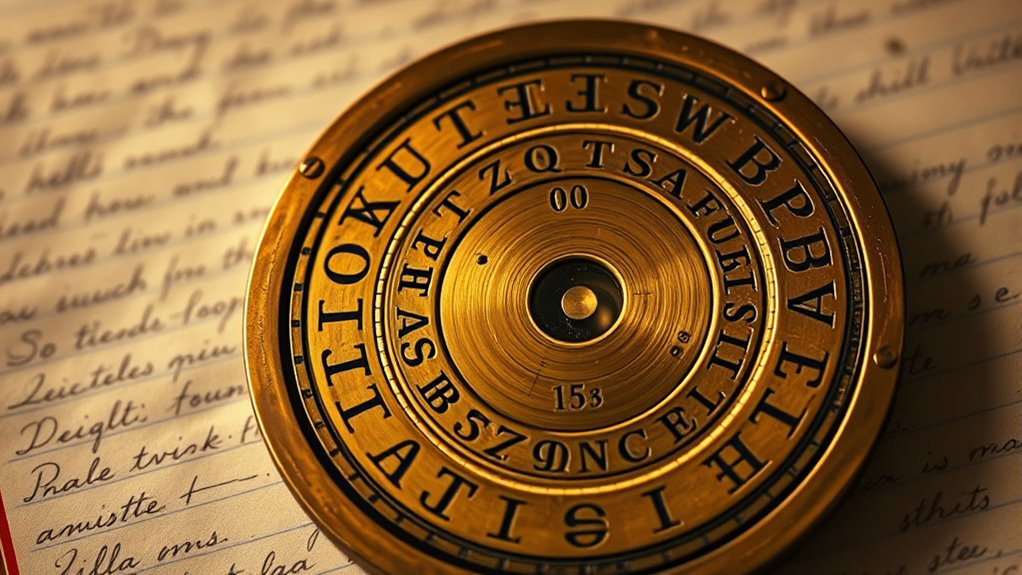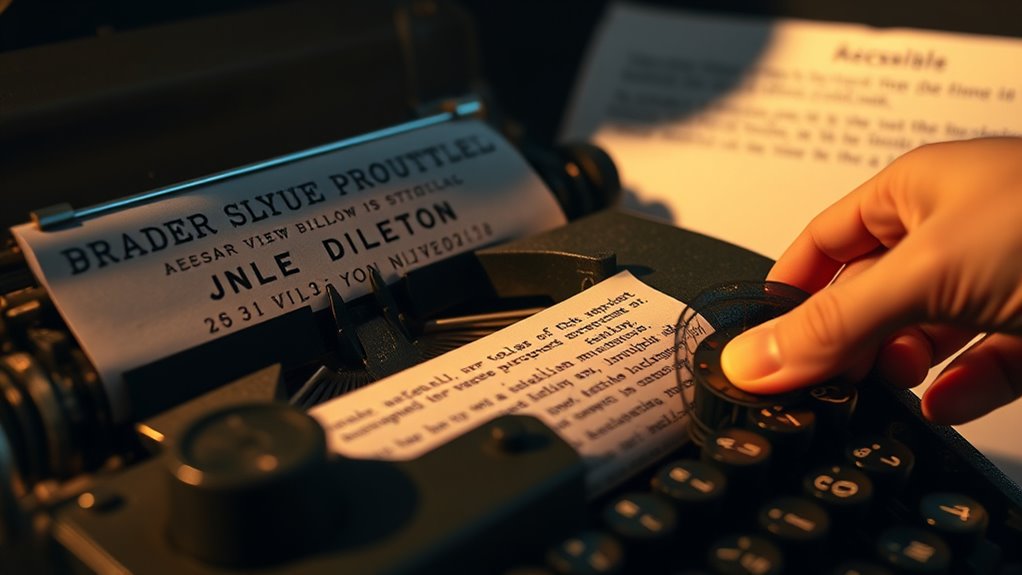A Caesar cipher works by shifting each letter in your message a fixed number of positions in the alphabet. For example, with a shift of 3, A becomes D, B becomes E, and so on. To encode, you move letters forward; to decode, you shift them back. This simple technique creates a scrambled version of your message, making it seem secret. If you want to understand the full process, keep exploring how this historic method functions.
Key Takeaways
- Caesar ciphers shift each letter by a fixed number of positions in the alphabet based on a secret key.
- During encryption, letters are moved forward; during decryption, they are shifted backward to recover the original message.
- The cipher uses a consistent shifting pattern, wrapping around the alphabet when reaching its end.
- It creates a simple substitution code, transforming readable text into scrambled characters.
- The method is easy to implement but vulnerable to frequency analysis and other cryptanalysis techniques.
The Concept Behind Caesar Ciphers

The concept behind Caesar ciphers is simple: it shifts each letter in the message by a fixed number of places in the alphabet. This shift is determined by the cipher key, which is a number you choose to specify how many positions to move each letter. When encrypting, you replace each original letter with a new one, based on this shift, creating a letter substitution. For example, with a cipher key of 3, A becomes D, B becomes E, and so on. This straightforward method transforms your message into a code that’s easy to decipher if you know the key. The core idea is that every letter is systematically replaced by another letter a set distance away, making the message appear scrambled to anyone without the cipher key.
How the Shifting Mechanism Operates

You can think of the shifting mechanism as an organized pattern that moves each letter by a set number of places in the alphabet. When you encrypt, the process follows a clear flow: identify the shift, move each letter accordingly, and produce the new message. Understanding this pattern helps you see exactly how the cipher transforms your original text into secret code. Additionally, the simplicity of the Caesar cipher makes it easy to understand how high contrast ratios influence the clarity of the encrypted message.
Alphabet Shift Pattern
Understanding how the alphabet shifts in a Caesar cipher works is essential to grasping its encryption process. The alphabet rotation occurs by shifting each letter a fixed number of places, creating a consistent pattern. For example, with a shift of 3, A becomes D, B becomes E, and so on. This pattern maintains letter frequency, which can sometimes reveal clues to codebreakers. Recognizing the pattern is important for encryption and decryption processes in cryptography.
Encryption Process Flow
When encrypting a message with a Caesar cipher, the shifting mechanism is applied systematically to each letter. You start with your key, which determines the cipher rotation—how many positions each letter shifts in the alphabet. As you process each character, you shift it forward by the key value, wrapping around if needed. Proper key management is essential; keeping the key secret guarantees your message remains secure. The process is straightforward: for every letter, add the key value to its position in the alphabet, then convert it back to a letter. This consistent shifting creates the encrypted text. When decrypting, you reverse the process using the same key, shifting in the opposite direction to retrieve the original message. This flow highlights how the shifting mechanism operates systematically through cipher rotation. Additionally, understanding the encryption process flow helps in assessing the security strength of the cipher.
Encoding and Decoding Messages

Encoding and decoding messages with a Caesar cipher involves shifting each letter of the plaintext by a fixed number of positions in the alphabet. To encode, you replace each letter with the one a set number of places away; decoding reverses this shift. This simple method relies on knowing the shift value, but it’s vulnerable to techniques like frequency analysis, where you analyze letter patterns to break the code. While this cipher isn’t secure for modern cryptography, understanding its process helps you grasp basic encryption principles. When decoding, you reverse the shift to reveal the original message. This straightforward approach highlights how ciphers transform messages, even if they’re easily cracked by more advanced cryptographic methods used today. Remember, the core idea is shifting letters systematically to encode and decode information. Additionally, understanding basic encryption like Caesar ciphers provides foundational knowledge for more complex security techniques and cryptography concepts.
Examples of Caesar Cipher in Action

You’ll see how shifting letters transforms messages with a simple example, making it easy to understand the process. Real-world uses, like secret codes in history, show how Caesar ciphers kept information safe. These examples highlight how this ancient method still influences modern encryption techniques. Interestingly, understanding the concept of horsepower can also help explain how electric dirt bikes generate power efficiently.
Shifting Letters Example
Have you ever wondered how a Caesar cipher shifts letters in practice? It all comes down to letter substitution using a specific shift pattern. For example, if you choose a shift of 3, each letter moves three places forward in the alphabet. So, A becomes D, B becomes E, and so on. When you reach the end of the alphabet, you wrap around—so, X shifts to A, Y to B, Z to C. This simple shift pattern transforms your message into an encrypted form that’s difficult to read without knowing the key. By applying this method consistently across your text, you create a straightforward, yet effective code. The letter substitution process illustrates how the Caesar cipher uses a fixed shift to encode messages, demonstrating its basic encryption principle.
Real-World Cipher Uses
Ever wondered how Caesar ciphers have been used beyond classroom puzzles? Historically, simple cipher tools like Caesar ciphers served as early encryption algorithms to hide messages. During wartime, soldiers and spies used this method to encode sensitive information, making it harder for enemies to intercept. While modern encryption algorithms are more complex, Caesar ciphers laid the groundwork for understanding basic encryption principles. Today, they’re often used as educational tools to introduce cryptography concepts or for fun puzzles. Some security systems still incorporate basic shift ciphers as part of layered encryption, though they’re not secure on their own. Recognizing their role in history helps you appreciate how simple ciphers contributed to the development of advanced cipher tools used in digital security today. Basic encryption principles continue to influence modern data protection methods.
Strengths and Limitations of This Method

Caesar ciphers are simple to implement and understand, which makes them accessible for learning basic encryption concepts. However, their simplicity also reveals their main limitation: they are easily broken using basic cryptanalysis techniques, such as frequency analysis. This vulnerability means they offer little security for protecting sensitive information today. Compared to modern cryptography, Caesar ciphers are outdated and ineffective against sophisticated attacks. Their strength lies in educational value, helping you grasp fundamental encryption ideas, but they fall short for real-world security needs. You should see them as a stepping stone rather than a practical solution. While they demonstrate the basics of shifting characters, they lack the complexity required to withstand modern cryptanalytic methods. Additionally, understanding their weaknesses provides insight into the evolution of cryptographic security and the importance of more advanced encryption methods.
The Historical Significance of Caesar Ciphers

The Caesar cipher holds a crucial place in the history of cryptography because it was one of the earliest known methods used to encode messages. Its significance lies in its role in ancient military and secret communication, helping leaders protect essential information. During Roman times, Julius Caesar used this cipher to send confidential messages to his generals, maintaining strategic advantages. This simple substitution method influenced future encryption techniques and demonstrated the importance of secure communication. The table below highlights its historical impact:
| Era | Usage | Significance |
|---|---|---|
| Ancient Rome | Military commands | Kept strategic info secret |
| Middle Ages | Diplomatic correspondence | Enhanced secure communication |
| Modern times | Foundation for modern cryptography | Inspired development of advanced algorithms |
Furthermore, understanding the origin of the Caesar cipher provides insight into how early cryptographers approached the challenge of message security and laid the groundwork for more complex encryption methods.
Frequently Asked Questions
Can Caesar Ciphers Be Used for Modern Encryption?
You might wonder if Caesar ciphers are useful today. While they lack security for modern encryption, their historical significance and educational value are still relevant. They help you understand basic encryption concepts and the evolution of cryptography. Despite their simplicity, learning about Caesar ciphers offers insights into how encryption has advanced, making them a useful tool for teaching fundamental principles, even if they’re not suitable for protecting sensitive information now.
How Secure Are Caesar Ciphers Against Current Hacking Techniques?
You might think Caesar ciphers are secure, but cryptanalysis vulnerabilities prove otherwise. These ciphers are easily broken with simple techniques like frequency analysis, making them highly insecure against modern hacking methods. Despite their historical significance, they don’t stand up to current cybersecurity standards. Their simplicity exposes them to quick decryption, so you shouldn’t rely on Caesar ciphers for protecting sensitive information today.
Are There Variations of the Caesar Cipher?
You’ll find that there are several variations of the Caesar cipher, especially involving shift variations. Instead of a fixed shift, you can use different alphabet shifts for different parts of the message, making it harder to crack. Some variations include the Vigenère cipher, which combines multiple shifts, and the affine cipher, which uses mathematical functions. These shift variations increase complexity, but they still rely on the basic concept of alphabet shifts.
Who Invented the Caesar Cipher and When?
Ever wondered who created the first historical encryption? Julius Caesar, the renowned Roman general, invented the Caesar cipher around 58-50 BC. His goal was to protect sensitive messages during wartime, making it a simple yet effective encryption method for his time. Do you realize how this early cryptography laid the foundation for modern encryption? Caesar’s innovation changed the way secrets were kept, influencing cryptography for centuries to come.
How Does Frequency Analysis Help Break Caesar Ciphers?
You use frequency analysis to break Caesar ciphers by examining letter frequency patterns in the encrypted message. Since certain letters appear more often in typical language, you compare the ciphertext’s letter frequency with normal letter frequency. Shift analysis then helps you determine the shift used in the cipher. By matching these patterns, you can accurately decode the message without guessing, revealing the original plaintext.
Conclusion
Now that you understand how Caesar ciphers shift letters to hide messages, imagine sending a secret note to a friend, just like Julius Caesar did. For example, if you shift “MEET ME AT NOON” by 3, it becomes “PHHW PH DW QRRQ.” This simple method shows how encryption can protect your messages, even if it’s easy to crack. With a little creativity, you can keep your secrets safe and have fun coding your own messages.









